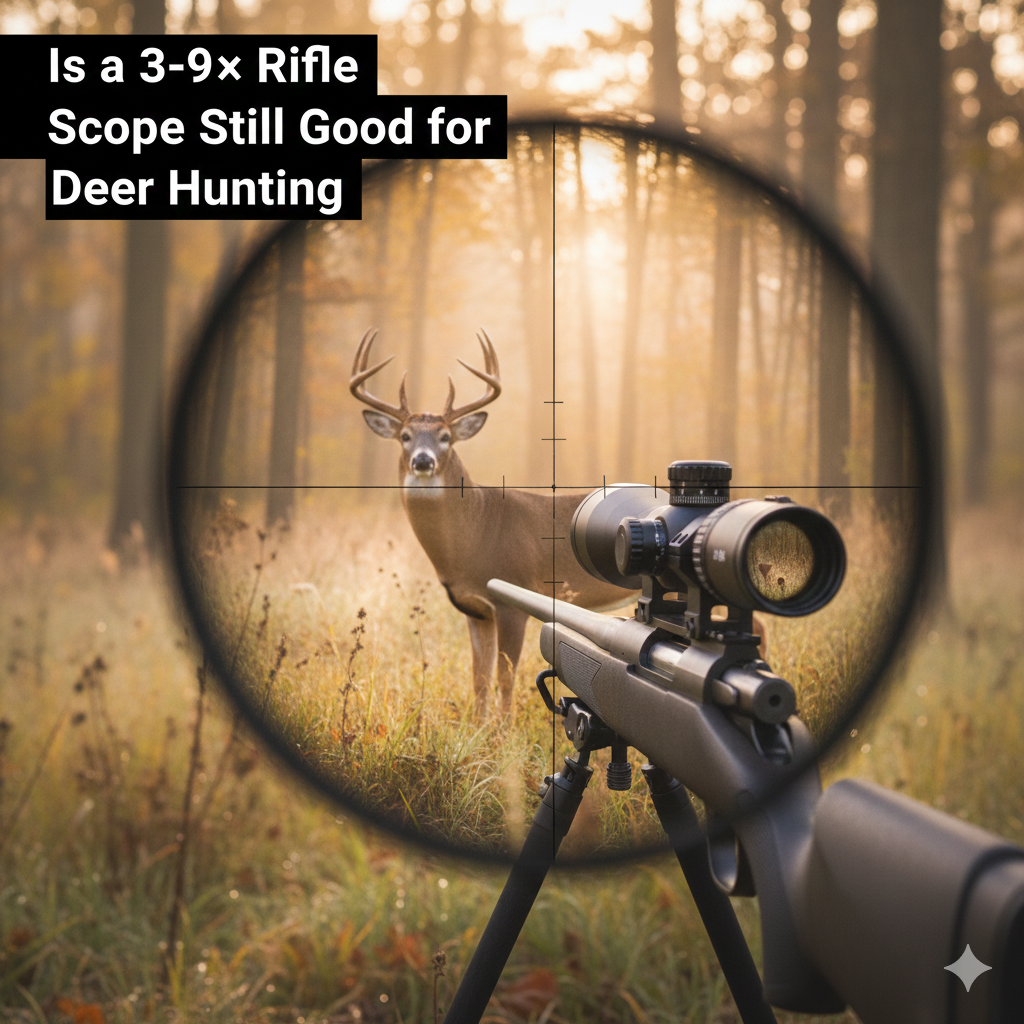Is a 3–9× Rifle Scope Still Good for Deer Hunting? (Full Expert Guide 2025)

For decades, the 3–9×40 rifle scope has been one of the most iconic optics used by deer hunters across North America and Europe. Generations of hunters grew up carrying rifles topped with this exact magnification range, and for many, it remains the trusted standard.
However, with today’s surge in modern long-range scopes such as 4–16×, 3–15×, and even 5–25×—hunters are starting to question whether the classic 3–9× scope is still practical in 2025. With advanced features like illuminated reticles, ballistic turrets, and first focal plane systems now more common, the traditional 3–9× setup can seem outdated at first glance.
But when examined through the lens of real-world deer hunting, the truth becomes clear: the 3–9× rifle scope is far from obsolete. In fact, it remains one of the most effective and relevant magnification ranges for everyday deer hunters.
Table of Contents
- Understanding What a 3–9× Scope Really Offers
- Why the 3–9× Scope Is Still Perfect for Typical Deer-Hunting Distances
- Low-Light Performance: The Real Strength of the 3–9× Scope
- Why Lightweight Optics Matter More Than People Think
- Simplicity: The Hidden Advantage That Modern Optics Can’t Replace
- Unmatched Durability and Reliability in Harsh Weather Conditions
- Situations Where a 3–9× Scope May Not Be Ideal
- Why the 3–9× Scope Still Reigns as the Perfect Deer-Hunting Optic
- Conclusion
Understanding What a 3–9× Scope Really Offers
A 3–9× scope provides variable magnification from three times up to nine times, an ideal range for typical whitetail and mule deer hunting environments. At 3× power, the shooter enjoys a wide field of view, allowing fast target acquisition, easier visibility in thick cover, and greater awareness of surrounding movement.
At the upper end, 9× power affords enough magnification to carefully place shots at 200–300 yards without sacrificing image stability. This combination of low-end speed and high-end precision is exactly why the 3–9× magnification range became the standard in the first place.
More importantly, it matches the practical shooting distances at which deer are actually harvested, rather than theoretical long-range distances hunters may practice at the range.
Why the 3–9× Scope Is Still Perfect for Typical Deer-Hunting Distances
Many hunters assume they need more magnification because long-range content is popular online. But real-world hunting data tells a very different story. Studies from multiple wildlife agencies show that 75% to 90% of all whitetail deer are taken inside 200 yards, with a significant percentage falling within 50–125 yards especially in timber, brush country, and tree-stand setups.
Mule deer hunters may encounter slightly longer ranges, but the overwhelming majority of ethical shots still fall under 300 yards. These numbers reveal a crucial fact: a 3–9× scope is designed exactly for the distances where deer are most commonly harvested.

At close ranges, 3× magnification allows the hunter to track a moving deer quickly, react to unexpected appearances, and make accurate shots without struggling to find the animal in the reticle. High magnification at close range can actually become a disadvantage, reducing the field of view and increasing the time needed to acquire a target.
At longer distances 150 to 300 yards—9× magnification provides a stable and clear view of the deer’s vital zone. A deer’s chest, measuring roughly 8–10 inches in diameter, is easily distinguishable at these distances without the need for extreme zoom. In practical terms, a 3–9× scope does everything most deer hunters will ever need.
Low-Light Performance: The Real Strength of the 3–9× Scope
Another major reason the 3–9× scope continues to dominate deer hunting is its superior low-light performance. Deer are most active during dawn and dusk, which means your scope must handle low-light conditions exceptionally well. A 3–9×40 or 3–9×50 scope often delivers better brightness and clarity at these times than many high-magnification scopes because it contains fewer internal lenses and simpler optical paths.
More complex scopes, especially budget models with extreme magnification, struggle to maintain light transmission and edge-to-edge clarity when the sun is low. The simplicity of the 3–9× design allows more natural light to pass through, providing a sharper, brighter image exactly when it matters most. This advantage is especially noticeable when trying to identify antlers or body angles in the final minutes of shooting light.
Why Lightweight Optics Matter More Than People Think
Weight and handling are often overlooked in scope selection, but they have a direct and significant impact on hunting performance. Modern high-magnification scopes are often larger and heavier, sometimes adding more than 20–30 ounces to the rifle. This extra weight can make a previously balanced rifle feel front-heavy, slower to shoulder, and harder to keep steady during off-hand shots.
By comparison, most 3–9× scopes weigh between 11 and 16 ounces, maintaining the rifle’s natural balance and enabling quicker reaction times. Hunters who cover long distances, hike rugged terrain, or stalk deer on foot immediately benefit from a lighter setup.
Even in a tree stand or blind, a balanced rifle feels more comfortable and easier to maneuver quietly. The lightweight nature of a 3–9× scope is not simply a convenience it is part of what makes the scope so effective for deer hunting.
Modern scopes often include a long list of advanced features such as illuminated reticles, ballistic drop compensation systems, and adjustable turrets. While these are useful for long-range shooters or precision hunters, they introduce layers of complexity that the average deer hunter does not need. In a high-pressure moment like when a buck steps into a shooting lane for only a few seconds the last thing you want is to be adjusting turrets or deciphering a complicated reticle.
This is where the 3–9× scope shines. Its simplicity eliminates the possibility of confusion in critical moments. You keep the scope set to an appropriate magnification for the environment you are in, and when a deer appears, you focus on shot placement rather than equipment settings. The intuitive, straightforward nature of a 3–9× scope is a huge advantage that even advanced optics cannot replicate without sacrificing speed.
Unmatched Durability and Reliability in Harsh Weather Conditions
The durability of a scope is not something most hunters think about until they experience a failure in the field. Scopes with complex internals have more components that may loosen, fog, or lose zero over time especially when exposed to recoil, rain, snow, or freezing temperatures. The classic 3–9× design is mechanically simple, which makes it exceptionally reliable. Many hunters continue using the same 3–9× scope for twenty or thirty years without any issues.
Its ruggedness comes from having fewer moving parts and a simpler erector system, making it resistant to weather changes, bumps, and accidental drops. Whether you’re hunting in the heat of early season, the rain of mid-fall, or the freezing temperatures of late season, a 3–9× scope is built to hold zero and deliver dependable performance in all conditions.
Situations Where a 3–9× Scope May Not Be Ideal
Although the 3–9× scope excels in most deer-hunting environments, there are specific situations where a different magnification range might be more appropriate. Western hunters who frequently encounter mule deer or antelope across large open spaces may face legitimate long-range shooting opportunities beyond 350 or 400 yards. In these cases, higher magnification can help in identifying distant animals, evaluating antler size, and placing precise shots at longer distances.
Additionally, hunters with aging eyes may appreciate the added clarity that 12× or 16× magnification provides. Competitive shooters or those who regularly practice long-range precision shooting might also prefer more advanced optics with ballistic turrets and first focal plane reticles. However, these use cases represent exceptions rather than the norm, and most deer hunters will rarely find themselves needing such features.
Why the 3–9× Scope Still Reigns as the Perfect Deer-Hunting Optic
Ultimately, the ongoing relevance of the 3–9× scope comes down to its balance of speed, clarity, practicality, and reliability. It is specifically designed around the distances and conditions that deer hunters encounter most frequently. The magnification range matches real-world hunting scenarios, the lightweight design enhances handling, the optical simplicity improves low-light performance, and the durability ensures years of consistent use.
While technology continues to evolve, the fundamentals of deer behavior and common hunting environments have not changed. The 3–9× scope remains effective because it aligns perfectly with the true needs of everyday hunters, rather than the theoretical demands of long-range shooting culture.
In 2025 and beyond, the 3–9× rifle scope stands strong as one of the best and most practical choices available for deer hunters of all experience levels. It offers everything necessary for ethical, accurate, and confident hunting across the vast majority of situations. Whether you are a beginner selecting your first optic or a seasoned hunter evaluating modern options, the 3–9× scope deserves to remain at the top of your list.
Conclusion
In the end, the 3–9× rifle scope is still one of the best and most practical choices for deer hunting. It offers the perfect balance of clarity, low-light performance, and easy handling for the distances where most deer are actually taken. While newer high-magnification scopes have their place, the classic 3–9× remains reliable, affordable, and ideal for real-world hunting. For most hunters, it continues to be the smartest and most effective option in the field.






